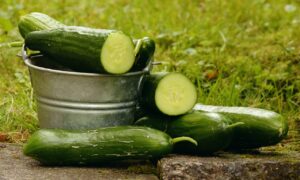
Photo by Karolina Grabowska: https://www.pexels.com/photo/foods-on-the-table-5717983/
Balanced Diet
A balanced diet is the foundation of good health and well-being. It refers to consuming a variety of foods in appropriate proportions to provide the body with the nutrients it needs to function optimally.
A well-balanced diet ensures that your body receives all the essential nutrients, vitamins, minerals, and energy it requires for growth, repair, and overall vitality.
In this article, we will explore the significance of a balanced diet, its key components, and practical tips for achieving and maintaining a healthy eating pattern.
What Is a Balanced Diet?
A balanced diet refers to a way of eating that provides all the essential nutrients, vitamins, and minerals in appropriate proportions to support optimal health and well-being.
It involves consuming a variety of foods from different food groups in the right quantities to ensure the body receives the necessary nutrients it needs to function properly.
Consuming a balanced diet ensures that your body receives the necessary nutrients for optimal functioning and overall health.
A balanced diet is synonymous with a complete diet, as it provides the appropriate ratio of vitamins, minerals, essential nutrients, and calories that align with your body’s unique requirements.
To ensure adequate nutrition, a significant portion of your daily calorie intake should come from the following food groups: Fresh fruits, Fresh vegetables, Whole grains, Legumes, Nuts, and Lean proteins.
The Dietary Guidelines for Americans provide detailed information on the recommended daily intake of each nutrient.
Understanding a Balanced Diet
A balanced diet is characterized by the intake of a diverse range of foods from different food groups.
These food groups include fruits, vegetables, whole grains, lean proteins, dairy or dairy alternatives, and healthy fats.
Each food group offers unique nutrients that contribute to overall health.
Fruits and vegetables are rich in vitamins, minerals, and antioxidants, while whole grains provide fiber and essential carbohydrates.
Lean proteins, such as poultry, fish, legumes, and nuts, supply amino acids necessary for growth and repair.
Dairy products or plant-based alternatives provide calcium for bone health, and healthy fats like avocados and nuts offer energy and essential fatty acids.
Benefits of a Balanced Diet
Consuming a balanced diet has numerous benefits for our overall well-being and helps keep us healthy throughout our lives. A balanced diet also plays a crucial role in maintaining both our physical and mental well-being.
Firstly, a balanced intake of nutrients helps maintain a healthy weight, preventing excessive weight gain or loss.
Moreover, a lack of proper exercise increases the risk of obesity and various diseases associated with the metabolic syndrome, including type 2 diabetes and high blood pressure.
Without a balanced diet, our bodies become more susceptible to various health issues such as diseases, infections, fatigue, and decreased performance. Children who lack nutritious foods may experience growth and developmental problems, poor academic performance, and frequent infections.
Secondly, a balanced diet supports optimal organ function, including the heart, brain, and digestive system. It reduces the chances of developing chronic health conditions and diseases like heart disease, diabetes, and certain cancers.
Research conducted by the Center for Science in the Public Interest establishes a direct link between a poor diet and four of the top ten leading causes of death: cancer, stroke, heart disease, and type 2 diabetes.
Additionally, a balanced diet enhances the immune system, enabling the body to defend against infections and illnesses.
It also promotes healthy skin, hair, and nails due to the intake of vitamins and minerals necessary for their maintenance.
Lastly, a balanced diet provides sustained energy levels throughout the day, improving productivity and overall quality of life.
By maintaining a balanced diet, you actively provide your body with the essential nutrients it needs to function optimally. This promotes good health and reduces the risk of chronic illnesses.
The Calorie Requirements
Calories refer to the energy stored in food, and our body utilizes these calories for essential functions such as walking, breathing, thinking, and other vital processes.
Calories do not constitute a physical component; instead, they measure the energy acquired by our body through the breakdown and metabolism of food.
The specific number of calories an individual needs each day can vary depending on several factors, including age, height, weight, gender, and activity level.
Goals related to weight loss, maintenance, or gain also influence the recommended calorie intake.
It is important to note that males typically require more calories than females, and individuals who engage in regular exercise generally need more calories compared to those leading a sedentary lifestyle.
The USA Health website states that adult women typically require an estimated range of 1,600 to 2,400 calories per day, while adult men may need around 2,000 to 3,000 calories per day.
The table below presents estimated calorie needs for maintaining calorie balance among different age and gender groups at two distinct levels of physical activity.
Table
| Person | Age | Calorie requirements |
| Sedentary children | 2–8 years | 1,000–1,400 |
| Active children | 2–8 years | 1,000–2,000 |
| Females | 9–13 years | 1,400–2,200 |
| Males | 9–13 years | 1,600–2,600 |
| Active females | 14–30 years | 2,400 |
| Active males | 14–30 years | 2,800–3,200 |
| Sedentary females | 14–30 years | 1,800–2,000 |
| Sedentary males | 14–30 years | 2,000–2,600 |
| Active people | 30 years and over | 2,000–2,600 |
| Sedentary people | 30 years and over | 1,600–2,400 |
Online tools such as those found at www.supertracker.usda.gov can provide more accurate approximations for individuals seeking a more precise calculation of their calorie needs, as these calorie estimates are intended as general guidelines.
Key Components of a Balanced Diet
Eating a healthy and balanced diet is extremely important for maintaining good health and overall well-being.
To achieve a balanced diet, it is essential to incorporate all the necessary components in the appropriate amounts.
These key components encompass a variety of foods and nutrients from these classes of foods, including carbohydrates, proteins, fats, vitamins, minerals, and water.
These key components encompass a variety of foods and nutrients from the following classes of foods: carbohydrates, proteins, fats, vitamins, minerals, and water.
This means that you are consuming high-quality nutrients that provide sustained energy throughout the day.
The proper balance of these components is crucial for optimal bodily functions, keeping you strong and full of vitality.
Let’s delve into each of these key components of a healthy and balanced diet, one by one, to gain a better understanding of their significance.
Proteins
Proteins are the building blocks of our bodies. They play a crucial role in repairing and building tissues, supporting immune function, and producing enzymes and hormones.
Good sources of protein include lean meats, poultry, fish, beans, lentils, nuts, and dairy products.
Carbohydrates
Carbohydrates are the primary source of energy for our body. They provide fuel for our brain and muscles.
Choose complex carbohydrates such as whole grains, fruits, vegetables, and legumes, as they are rich in fiber and nutrients compared to refined carbohydrates.
Fats
Healthy fats are an essential part of a balanced diet.
They provide energy, support cell growth, and help in the absorption of fat-soluble vitamins.
Include sources of unsaturated fats like avocados, nuts, seeds, and olive oil in your diet while limiting saturated and trans fats found in fried foods, processed snacks, and fatty meats.
Vitamins
Vitamins are essential for various bodily functions and support overall health.
Eating a variety of fruits and vegetables can provide a wide range of vitamins, including vitamin A, vitamin C, vitamin D, vitamin E, and the B-vitamins.
Minerals
Minerals, like vitamins, are necessary for proper bodily functions.
Important minerals include calcium for strong bones and teeth, iron for oxygen transport, potassium for nerve function, and zinc for immune support.
Good sources of minerals include dairy products, leafy greens, legumes, whole grains, and lean meats.
Fiber
Fiber is essential for maintaining a healthy digestive system and promoting satiety.
It aids in regulating blood sugar levels, preventing constipation, and reducing the risk of certain diseases.
Whole grains, fruits, vegetables, and legumes are excellent sources of dietary fiber.
Water
While not a nutrient, water is essential for our body’s proper functioning.
It helps regulate body temperature, aids in digestion, transports nutrients, and flushes out waste products.
Stay hydrated by drinking an adequate amount of water throughout the day.
Selecting a Well-Balanced Diet
Food is not only enjoyable and makes us happy, but it also provides our body with the essential things it needs to stay healthy.
These important things are called nutrients, vitamins, minerals, and energy.
It’s important to know that there are no foods that are completely good or completely bad.
It’s all about finding balance in our diet. When we understand how to balance what we eat, we can both enjoy our food and maintain good health.
Maintaining a balanced diet is crucial for promoting good health and overall well-being.
A well-balanced diet includes a variety of foods from different food groups, ensuring that your body receives all the essential nutrients it needs to function optimally.
Here are some guidelines to help you choose a balanced diet:
Include A Variety of Fruits and Vegetables.
Fruits and vegetables are rich in vitamins, minerals, and antioxidants. Aim to include a colorful array of fruits and vegetables in your meals to ensure a diverse range of nutrients.
Opt For Whole Grains
Whole grains such as brown rice, whole wheat bread, and oats are high in fiber and provide essential nutrients.
Replace refined grains with whole-grain alternatives to increase your fiber intake and promote better digestion.
Incorporate Lean Proteins
Choose lean sources of protein such as chicken, fish, legumes, and tofu.
These foods provide essential amino acids for muscle growth, repair, and overall body function.
Include Healthy Fats
Include sources of healthy fats in your diet, such as avocados, nuts, seeds, and olive oil.
These fats are beneficial for heart health and provide essential fatty acids.
Don’t Forget About Dairy or Alternatives
Dairy products like milk, yogurt, and cheese are excellent sources of calcium and protein. If you are lactose intolerant or prefer non-dairy options, choose fortified plant-based alternatives like soy milk or almond milk.
Stay Hydrated
Drink an adequate amount of water throughout the day to stay hydrated. Water is essential for digestion, nutrient absorption, and overall body functions.
Table: Key Nutrients for a Healthy and Well-Balanced Diet
| Nutrient | % of Daily Calories | Function | Source |
| Carbs | 45–55% | Provides energy | Grains (wheat, maize, corn, millet, oats, rice, flour, pasta, and noodles), potatoes, sweet potatoes, yams, and fruits (natural sugars) |
| Protein | 10–35% | Supports tissue growth and maintenance | Meat, fish, nuts, eggs, soy, beans, and pulses |
| Fat | 20–35% | Provides energy, aids hormone production, and stores energy | Nuts, seeds, plant oils, dairy products (milk, cheese) |
| Fiber | Included in carbs | Regulates blood sugar levels and promotes bowel function and health | Peas, beans, vegetables, fruits, oats, whole grains, brown rice, nuts, and seeds |
| Vitamins and minerals | Trace | Regulates metabolism, aids cell growth, and performs other biochemical functions. | Varied sources, including vegetables, lean meats, nuts, and seeds. |
| Water | 0 | Maintains hydration | Drinking water or other beverages. Approximately 20% of our water intake comes from food. |
Limit Added Sugars and Processed Foods
Minimize your intake of sugary drinks, desserts, and processed foods, as they are often high in calories and low in nutrients. They are commonly referred to as “empty calories.”
Instead, opt for whole, unprocessed foods whenever possible.
Practice Portion Control
Portion control is a key aspect of maintaining a balanced diet.
It involves being mindful of the quantity of food you consume to ensure that you’re getting the right amount of nutrients without overeating.
Moderation is key to maintaining a balanced diet.
One simple way to practice portion control is by using visual cues. For example, a serving of lean protein, such as chicken or fish, should be about the size of your palm.
A serving of carbohydrates, like rice or pasta, can be measured by cupping your hand. And a serving of vegetables should be roughly the size of your fist.
Note
Remember, each person’s dietary needs may vary, so it’s essential to consult with a healthcare professional or registered dietitian for personalized advice. By choosing a well-balanced diet, you can nourish your body with the right nutrients and promote good health for years to come.
Practical Tips for Adopting a Balanced Diet
Adopting a balanced diet is achievable through simple lifestyle changes and mindful eating habits.
Start by planning your meals in advance and incorporating a variety of nutrient-rich foods into each meal.
Focus on portion control to avoid overeating or undereating. Include more whole foods and minimize processed foods, as they often contain excessive salt, sugar, and unhealthy fats.
Snack on fruits, vegetables, and nuts instead of sugary or salty snacks.
Make water your primary beverage and limit the consumption of sugary drinks.
Experiment with different cooking methods to retain the nutritional value of foods.
Lastly, listen to your body’s hunger and fullness cues and eat mindfully, savoring each bite.
To have a healthy, balanced diet, it’s important to eat a variety of different foods.
Some foods, like fruits and vegetables, are really good for us, and it’s recommended to have “5 a day” of them. They give us important nutrients that our body needs to stay healthy.
On the other hand, foods like cakes and biscuits are not as good for us.
They taste yummy, but they don’t have as many nutrients. It’s okay to enjoy them sometimes, but it’s best to have them in small amounts because they don’t give our bodies as much goodness.
So, when we think about our meals, we want to make sure we have lots of fruits and vegetables because they are super nutritious.
And when it comes to treats like cakes and biscuits, it’s better to enjoy them in moderation. These foods provide mostly calories with very little nutritional value.
By choosing a wide range of healthy foods and keeping treats in check, we can have a balanced diet that helps us stay healthy and feel good.
Summary
A balanced diet is the cornerstone of a healthy lifestyle, providing your body with the necessary nutrients for optimal functioning.
By incorporating a variety of nutrient-rich foods from different food groups, you can ensure that you are nourishing your body and promoting overall well-being.
A balanced diet not only helps maintain a healthy weight but also supports organ function, lowers the risk of chronic diseases, boosts the immune system, and enhances physical and mental performance.
To achieve a balanced diet, remember to include the key components in appropriate proportions.
Carbohydrates provide energy and can be sourced from whole grains, fruits, and vegetables. Proteins are essential for growth and repair and can be found in lean meats, fish, legumes, and dairy products.
Healthy fats, like those found in avocados and nuts, support cell function and provide energy.
Vitamins and minerals are crucial for various bodily processes and can be obtained from a diverse range of fruits, vegetables, and whole foods.
Finally, hydration is essential, so make sure to drink enough water throughout the day.
Incorporating a balanced diet into your daily routine is achievable with some practical tips. Plan your meals in advance, focusing on nutrient-rich choices.
Practice portion control and avoid processed foods, opting for whole foods instead.
Snack on fruits, vegetables, and nuts for a healthier alternative. Make water your primary beverage and limit sugary drinks.
Choose cooking methods that retain the nutritional value of foods. And most importantly, listen to your body’s hunger and fullness cues, eating mindfully and savoring each bite.
By adopting these habits and making conscious choices about what you eat, you can fuel your muscles, support your overall health, and enjoy the benefits of a balanced diet.
Final Note
In conclusion, a balanced diet is essential for nourishing your body and promoting optimal health.
By including a variety of nutrient-rich foods from different food groups, you provide your body with the necessary fuel for growth, repair, and overall well-being.
Remember to incorporate carbohydrates, proteins, healthy fats, vitamins, minerals, and water in appropriate proportions.
With practical tips and mindful eating habits, you can easily integrate a balanced diet into your daily life.
Embrace the power of a balanced diet and unlock the potential for a healthier and more vibrant you.





